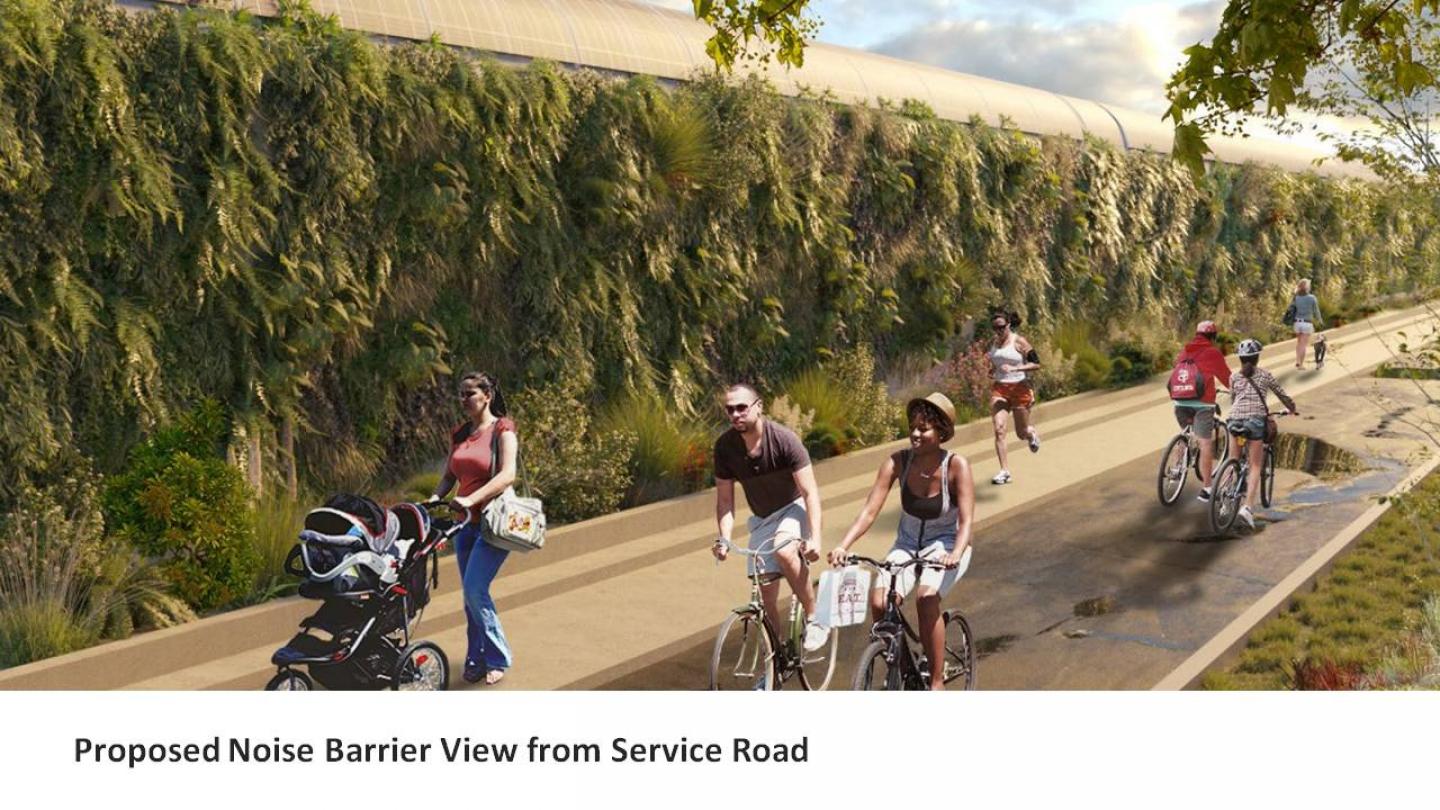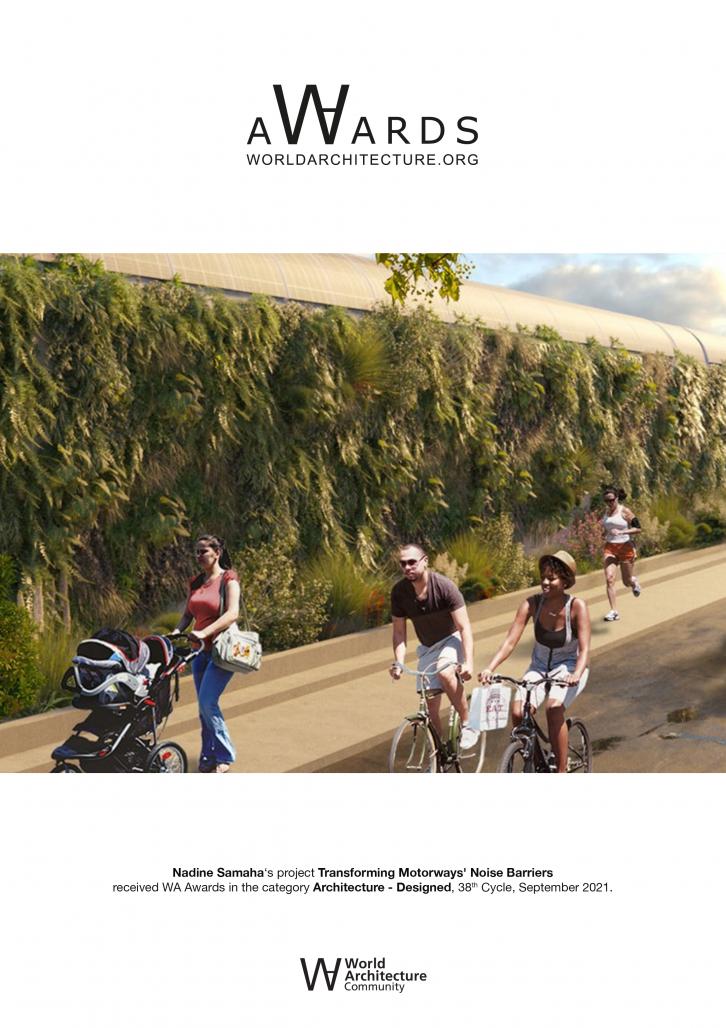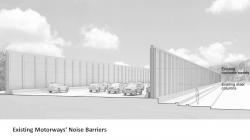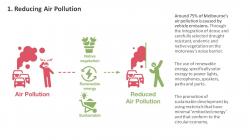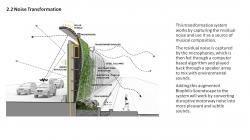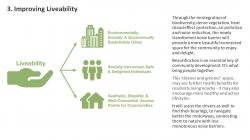Melbourne is part of the C40 Cities Climate Leadership Group, which includes over 94 affiliated cities. Established 14 years ago, C40 Cities recognizes that urgent climate action has to be at the center of all urban planning decisions. Major Cities have to reduce their greenhouse emissions and lower their temperature by 1.5 degrees (C40 Cities, 2019)
This is critical for Melbourne, which is considered a sprawling city. In recent years the city has experienced an exponential growth of residents moving to the Melbourne suburbs (Milman, 2015). These residents commute to Melbourne CBD through these established and new motorways. However, these existing and new infrastructure has meant an increase in rising temperatures, air, and noise pollution.
Our proposal aims to respond to climate change impact by addressing Melbourne motorways' negative effect on the environment. The Transformative Motorways' Noise Barriers will become ecological barriers that can improve the well-being of the residents and the drivers while enhancing biodiversity.
The detailed proposal aim at:
1. Reducing Air Pollution
Through increased native vegetation to absorb CO2 and other emissions from cars. Also by using renewable energy, such as adding solar panels to power lights on motorways, adjacent parks, and paths.
2. Reducing Noise Pollution
By adding an innovative noise transformation system to an existing noise barrier. It works by converting disruptive motorway noise into more pleasant, gentle sounds.
3. Improving Livability
Through the reintegration of biodiversity increased vegetation and noise reduction. The newly transformed noise barrier aims to provide shelter for the community and protection from rising temperatures.
2019
0000
1. Reducing Air Pollution
Around 75% of Melbourne’s air pollution is caused by vehicle emissions. Through the integration of dense and carefully selected drought resistant, endemic and native vegetation on the motorway’s noise barrier.
The use of renewable energy, specifically solar energy to power lights, microphones, speakers, paths, and parks.
The promotion of sustainable development by using materials that have minimal ‘embodied energy' and that conform to the circular economy.
1.1Dense Green Infrastructure
The green infrastructure will include a combination of vertical greening, climbers, planter boxes and rain gardens. The vegetation will grow on a natural medium.
The structure will create an ecological corridor that supports the existing fauna and flora and fosters biodiversity.
Dense green infrastructure is a critical component to improving air quality, reducing pollution exposure from vehicles’ emissions, and cutting back carbon by up to 63 percent. (University of Surrey, 2019).
1.2Renewable energy
The solar panels that will be installed will be efficient, flexible, and exposed to full North orientation. They will power existing light infrastructure on roadways, surrounding parks, walking paths, and maybe residential neighborhoods.
This installation in a short time will pay itself with excess feeding back to the grid.
Specified LED lights and any other electrical equipments will have to be energy efficient.
1.3 Sustainable and Recycled Materials
Materials for the structure and any other component will have to adhere to the 7 Key Elements of a circular economy.
Materials will be made from recycled materials, free from VOC and any other chemicals.
We are exploring the work of Dr. Veena Sahajwalla from the UNSW in Sydney who is changing the recycling industry with her "revolutionary" idea of using plastics and rubber in steel production.
2. Reducing Noise Pollution
Current methods of reducing motorway noise are focused on noise wall construction. This may be effective in attenuating noise levels, however, there is always residual noise that impacts the wellbeing of residents living nearby motorways.
This project will build on the 2016 RMIT - Trans-urban collaborative research project which tested a new approach to motorway noise management called ‘noise transformation’.
2.1 Noise Wall Modifications
The curvature at the top of the proposed modular structure covered with the flexible solar panels will work by reflecting the noise back onto the motorway.
This prevents sounds from propagating to surrounding suburbs and increasing further the attenuation of the overall noise level by up to 3dB.
2.2 Noise Transformation
This transformation system works by capturing the residual noise and use it as a source of musical composition.
The residual noise is captured by the microphones, which is then fed through a computer-based algorithm and played back through a speaker array to mix with environmental sounds.
Adding this augmented Biophilic Soundscape to the system will work by converting disruptive motorway noise into more pleasant and subtle sounds.
3. Improving Liveability
Through the reintegration of biodiversity, dense vegetation, heat island effect protection, air pollution, and noise reduction, the newly transformed noise barrier will provide a more beautiful-connected space for the community to enjoy and delight.
Beautification is an essential key to community development. It's what brings people together.
This ‘cleaner and greener’ space, may see further health benefits for residents living nearby - it may also encourage more healthy and active lifestyles.
It will assist the drivers as well to find their bearings, to navigate better the motorways, connecting them to nature with less monotonous noise barriers.
3.1 Affordable and Clean Energy SDG
Energy use is the main contributor to climate change, producing around 60 % of greenhouse gases. Incorporating solar panels in the retrofitted noise barriers will reduce greenhouse emissions, providing Clean Energy to power LED lights on motorways, parks, and paths even stretching to the surrounding neighborhoods.
Installing solar panels will have broader socio-economic benefits.
The solar power industry alone generated twice more workplaces as the coal or oil industry combined. According to a study in UTS, 75 % of construction and installation jobs now dominate the renewable energy labor market. By 2035 as many as half of the renewable energy jobs could be ongoing jobs in operation and maintenance.
3.2 Industry, Innovation, and Infrastructure
The new retrofit will be a sustainable and resilient infrastructure, It will support economic development and human well-being.
It will rely on resource-use efficiency with the adoption of clean and environmentally sound technologies.
Industry and Academics working together to provide a long-lasting solution.
The innovation in this proposal is the multifunctional purpose of the retrofit:
-Producing energy through Renewables
-Using a cradle to cradle modular system
-Reducing air pollution
-Transforming noise pollution
-Improving liveability
3.3 Sustainable Cities and Communities
Many existing motorway noise barriers are engineered for functionality. With no vegetation on the barrier itself, they tend to convey oppressiveness and hostility to local residents and drivers.
However, it has been recognized the city’s link to green space is critical to improving the city’s liveability, as it can provide physical and mental health benefits (Rozek, Gunn, Gannet, Hooper, Giles- Corti, 2017), such as psychological relaxation and stress alleviation (Braubach, Egorov, Mudu, Wolf, Ward Thompson, Martuzzi, 2017).
‘Health’ is now recognized as key to the design and occupation of sustainable, ‘liveable’ cities (Kamalipour, Henderson, Giles-Corti, Stephan, Trundle, Lowe, 2018).
3.4 Climate Action
For most cities to limit their temperature to under 2°C, more Climate Action has to be taken.
Global net CO2 emissions must drop by 45% between 2010 and 2030, and reach net zero around 2050.
The existing noise barriers do not even serve as reducing the traffic noise. Retrofitting them with a comprehensive and multi-functional purpose will address most of the Climate change issues.
Climate change and even a small increase in the temperature is affecting the habitats of several species, which must either adapt or migrate to areas with more favorable conditions. According to the Department of Agriculture, Water, and the Environment, more than 50 %of the world's marsupial species occur only in Australia.
Dr. Jordan Lacey,
Research Fellow in the School of Design RMIT
Mrs. Nadine Samaha,
Principal Architect level-arhitekture>konstrukt, LEED Green Associate, ESD Lecturer RMIT
RESEARCH & TECHNICAL SUPPORT
Uyen Nguyen - Animator
Stephen Mintern - Landscape Architect Elissar Mukhtar - Communications Specialist Tien Tran - Landscape Architect, 3D Visualizer Wei Guo - Interior Designer, 3D Visualizer
Lam Quang Le - Graphic Design Assistant
ACKNOWLEDGMENT
We would like to acknowledge the support of the Urban Futures (UF) and Design and Creative Practice (DCP Enabling Capabilities Platforms (ECP) at RMIT UniversityRESEARCH & TECHNICAL SUPPORT
Uyen Nguyen - Animator
Stephen Mintern - Landscape Architect Elissar Mukhtar - Communications Specialist Tien Tran - Landscape Architect, 3D Visualizer Wei Guo - Interior Designer, 3D Visualizer
Lam Quang Le - Graphic Design Assistant
ACKNOWLEDGMENT
We would like to acknowledge the support of the Urban Futures (UF) and Design and Creative Practice (DCP Enabling Capabilities Platforms (ECP) at RMIT University, in the creation of this proposal.
Transforming Motorways' Noise Barriers by Nadine Samaha in Australia won the WA Award Cycle 38. Please find below the WA Award poster for this project.
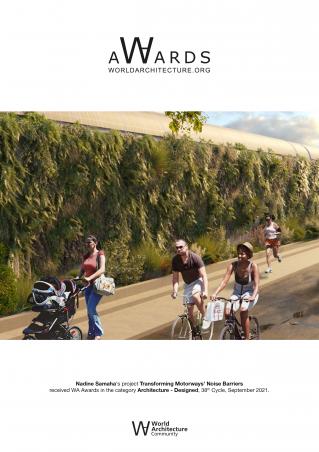
Downloaded 0 times.
